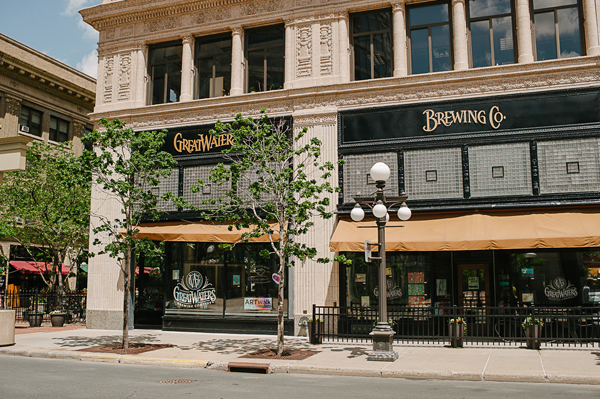
“It used to be the mystique, now it’s the science, you could call it art, or whatever you like,” says Chad Hilgenberg, surveying 28 stainless steel firkins chilling at 52 degrees. “But to do it consistently requires a lot of attention to detail and physical labor.”
He speaks of cask conditioning — the process of allowing fermented brew to undergo a gentle secondary fermentation in a smaller vessel, often adding different flavoring agents to make each batch unique.
This niche brew has recently enjoyed a considerable amount of attention, from popular Twin Cities festivals to international campaigns on its behalf. It’s a traditional style of brewing — unpasteurized, naturally carbonated, slow, and artisan. Cask ales are dismissed by haters as being warm and flat, and beloved by others for being subtle, patient, and alive.

Long before the firkin fad was reborn in earnest, Great Waters Brewing was laying the groundwork for an ambitious cask ale program that is now 15 years strong. When Sean O’Bryne opened Great Waters in 1997, he was looking for a hook.
“We wanted to do something different from the get-go,” he says. “When we were opening up, there was a brewpub, Sherlock’s Home in Minnetonka, that did cask beers and they were well known for it. I thought we could do it too — it’s different. And shortly after we opened, they closed. So we got to become sort of that cask place, and it hasn’t stopped since.”

The keys to the firkin kingdom, the sole brewpub in St. Paul, have recently been passed to Hilgenberg. A former CPA, he was the assistant to Bob DuVernois for two years, who left Great Waters to become head brewer at the inchoate Excelsior Brewing Company. Hilgenberg plans to continue the groundwork DuVernois has laid. “For now, we’re just going to do what we’ve been doing — that’s a big enough task as it is.”
As a class, the cask ales at Great Waters aren’t aggressively flavored. They’re mild and mellow, with substantial body while remaining a bit lower in alcohol. “This bar is known for making clean flavored cask beers,” says Hilgenberg. “A lot of that was Bob’s thing, and he showed me the way. I view the craft beer industry as leaning more towards sessionability in this part of the country. Other parts rely on heavy alcohol beers — I don’t think that’s a lasting trend. I think it’s more important to be able to enjoy pint after pint.”
Since each firkin is flavored in its own small batch, there’s lots of room for a brewer to get creative. Great Waters hasn’t yet ventured too far into cask craziness — that scary fringe when things like bubble gum and rock candy condition the brew to varying degrees of success. But this summer, they expect to produce a few fruit beers and some other infusions.

“We’re going to be starting our rotating specialty cask program,” Hilgenberg tells us. “All we do is pull off firkins of our Pale, or Brown, even our Blonde — and we cask them doing different things for each style. We’ll dry hop them, or pour in some cold-press coffee. We’ll add all sorts of stuff.” Last Saturday, the specialty cask was a silky, dry-hopped IPA.
“I’m a huge fan of working with locally-roasted coffee, that’s my kick right now,” he continues. “The last time we put on a firkin of the coffee stout it was gone in a day. I used J&S Bean Factory Tanzanian Peaberry. The stuff we have going now is a medium Peruvian organic roast. I put some in a firkin of the Mild, just to see if it would stand up to it.”
One can imagine how well coffee would take to their Blackwatch Oat Stout. Currently on cask at the pub, it’s a frothy, sweet-roasted brew with a heady chocolate / coffee aroma. “It’s made with malted and flaked oats. The malted oats are the portion that gives it that flavor.” Hilgenberg says he uses a popular Breiss roasted malt for the stout (we believe it’s the same malt used in, among other popular local stouts, Steel Toe Dissent). We’re not sure what the criteria was when it was named MSP Mag’s Sexiest Beer in the Metro, but we’re not arguing.
Also on cask lately is a Mild Ale they call New Centurian and an English-style Bitter house ale. The latter gets fermented in one of our favorite area brewery retrofits to date, a commercial cheese vat. Hilgenberg notes that the house ale seems to do well fermenting in a tank with a high surface area.

Instead of being pushed with CO2 as from a keg, cask beers are drawn out of the firkin by means of a “beer engine.” It’s an airtight pump like one you’d use to draw well water, which, incidentally, happens to be a Great Waters secret ingredient. “There’s a well right here in the building, and we’re the only ones that are allowed to use it” says Hilgenberg. “It helps because it’s not treated — we just use a simple carbon filter for our water.” With no fluoride content there’s no need for a reverse-osmosis treatment system like many breweries have. “We’re lucky. The pH is consistent all the time and it’s very clean.”
Consistency is the name of the game for Great Waters, and Hilgenberg is intent on putting in the work. “We make 7.5 barrel sized batches, and each batch creates 18 or 19 firkins, which have to be hand sanitized, hand filled, hand lifted onto the shelves. It takes a lot of care.” Considering that 30 percent of beer sales in a high-volume St. Paul hockey bar come from this process, the care is evident. As we talk and survey his coolers, O’Byrne whispers to Hilgenberg, who laughs and gives a thumbs up. A pallet of empty firkins had just been delivered.
May 30th, 2012: Updated to correct the brewer’s last name.

Comments are closed.